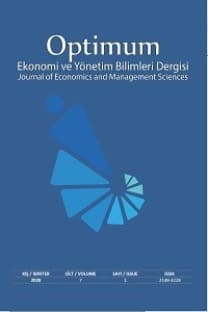Karadeniz Ekonomik İşbirliği Ülkelerinde Enerji Tüketimi ve Ekonomik Büyüme Arasındaki İlişkinin İncelenmesi
Bu çalışma Karadeniz Ekonomik İşbirliği Örgütüne (KEİ) dahil ülkelerin kişi başına düşen gayri safi yurtiçi hasılaları (KBGSYİH) ile kişi başına düşen CO2 oranları arasındaki ilişkiyi panel veri analizi yardımıyla incelemiştir. Ekonomik göstergelerdeki iyileşme, üretim artışı buna bağlı olarak kişi başına düşen gelirin artması tüketimi de arttırmaktadır. Tüketim artışı da çevre kirliliğinin en büyük faktörlerindendir. Özellikle gelişmekte olan ülkelerde çevre korunmasına yönelik çalışmalar henüz tamamlanamadığından gelir artışı ile beraber çevre kirliliği de sıklıkla rastlanan bir durumdur. Bu çalışmada KEİ’ye üye ülkelerin 1993-2013 yılları arası kişi başına düşen GSYİH ve CO2 değerleri arasındaki ilişki araştırılmış ve istatistiksel olarak anlamlı ilişkilerin varlığı tespit edilmiştir. Çevresel Kuznet Eğrisi Teorisi çerçevesinde, bu ülkelerin henüz eğrinin pozitif eğimli tarafında olduğu, ekonomik büyümelerinin çevre kirliliğine neden olduğu sonucuna ulaşılmıştır.
Anahtar Kelimeler:
Karadeniz İşbirliği Teşkilatına Üye Ülkeler, Ekonomik Büyüme, Enerji tüketimi, Panel Veri Analizi
Investigation of the Relationship between Energy Consumption and Economic Growth in Black Sea Economic Cooperation
This study examines the relationship between gross domestic product (GDP) per capita and the CO2 ratios per capita of countries including the Black Sea Economic Cooperation Organization (BSEC) with the help of panel data analysis. The improvement in economic indicators, the increase in production, the increase in per capita income also increases consumption. The increase in consumption is also the biggest factor of environmental pollution. Especially in the developing countries, environmental protection activities are not completed yet, so environmental pollution is also a common condition with the increase of income. In this study, the relationship between per capita GDP and CO2 values of the CEE member countries between 1993 and 2013 was investigated and statistically significant correlations were found. Within the framework of the Environmental Theory of Kuznets Curve, we have come to the conclusion that these countries are still on the positive sloping side of the curve, and that their economic growth has caused environmental pollution.
Keywords:
Black Sea Economic Cooperation Organization, Economic Growth, Energy Consumption, Panel Data Analysis,
___
- Arı A. ve Zeren F. (2011). CO2 Emisyonu ve Ekonomik Büyüme: Panel Veri Analizi, Celal Bayar Üniversitesi İİBF Yönetim ve Ekonomi, 18(2), 37-47.
- Baldassare, M., & Katz, C. (1992). The personal threat of environmental problems as predictor of environmental practices. Environment and Behavior, 24(5), 602-616.
- Başar S. ve Temurlenk M. S. (2007). Çevreye Uyarlanmış Kuznets Eğrisi: Türkiye Üzerine Bir Uygulama, Atatürk Üniversitesi İİBF Dergisi, 21(1), 1-12.
- Bimonte, S. (2002). Information access, income distribution, and the Environmental Kuznets Curve. Ecological Economics, 41(1), 145-156.
- Carson, R.T. (2010). The Environmental Kuznets Curve: Seeking Empirical Regularity and Theoretical Structure. Review of Environmental Economics and Policy, 4(1), 3-23.
- Congleton, R. D. (1992). Political institutions and pollution control. The Review of Economics and Statistics, 412-421.
- Çelik K. (2013). Karadeniz Ekonomik İşbirliği, Ekonomik Entegrasyon Küresel ve Bölgesel Yaklaşım (Editörler: Osman Küçükahmetoğlu, Hamza Çeştepe, Şevket Tüylüoğlu), Geliştirilmiş 3. Baskı, Ekin Yayıncılık, Bursa.
- Egli H. (2004). Environmental Kuznets Curve Evidence From Time Series Data for Germany, WIF-Institute of Economic Research, Working Paper: 3/28, 1-39.
- Evans, G. W. & Kantrowitz, E. (2002). Socioeconomic status and health: the potential role of environmental risk exposure. Annual review of public health, 23(1), 303-331.
- Greene, W. H. (2003). Econometric analysis. Pearson Education India.
- Grossman, G. & Kreuger, A. (1991). “Environmental Impacts of a North American Free Trade Agreement”, NBER Working Paper, No. 3914.
- Gujarati, D. (2004). Basic Econometrics. United States Military Academy, West Point.
- Hsiao, C. (2003). Analysis of panel data, 2nd. Cambridge: Cambridge University Press. Kose, MA, ES Kennedy, C. Steinberger, J. Gasson, B. Hansen, Y., Hillman, T., Havranek, M., ... & Mendez, G. V. (2009). Greenhouse gas emissions from global cities. Environmental science & technology, 43(19), 7297-7302.
- Kristrom, B. & Riera, P. (1996). Is the income elasticity of environmental improvements less than one?. Environmental and Resource Economics, 7(1), 45-55.
- Kuznets, S. (1955). “Economic Growth and Income Inequality”, American Economic Review, 45, 1, 1-28.
- Magnani, E. (2000). The Environmental Kuznets Curve, environmental protection policy and income distribution. Ecological Economics, 32(3), 431-443.
- Matyas, L. & Sevestre, P. (1996). The econometrics of panel data. A Handbook of the Theory with.
- Panayotou, T. (2000). “Economic Growth and the Environment”, CID Working Paper, No. 56.
- Prasad and ME Terrones (2003), Financial Integration and Macroeconomic Volatility, IMF Staff Papers, 50, 119-142.
- Stern, D. I. Common, M. S. & Barbier, E. B. (1996). Economic growth and environmental degradation: the environmental Kuznets curve and sustainable development. World development, 24(7), 1151-1160.
- Torras, M. & Boyce, J. K. (1998). Income, inequality, and pollution: a reassessment of the environmental Kuznets curve. Ecological economics, 25(2), 147-160.
- Yayın Aralığı: Yılda 2 Sayı
- Başlangıç: 2014
- Yayıncı: -
Sayıdaki Diğer Makaleler
Terörün Volatilitiye Etkisi: Türkiye BIST 100 Endeksinde Bir Uygulama
Esengül BACIK, Mustafa ÖZER, Serpil ALTINIRMAK
Fatih ÇEMREK, H. Naci BAYRAÇ, Hakkı POLAT
Türkiye’nin Avrupa Birliği Çevre Politikalarına Uyum Sürecinin Değerlendirilmesi
Mehmet Samet ERDEM, Füsun YENİLMEZ
Türkiye’de Sosyal Politikanın Dünü, Bugünü: Hayırseverliğin Kurumsallaşması mı? Gelişim mi?
Para ve Vergiler Arasındaki Nedensellik İlişkisi: OECD Ülkeleri Üzerine Bir İnceleme
Türkiye’de Eğitim ve Ekonomik Büyüme: Eşbütünleşme Yaklaşımı
Süreç İyileştirme: Vasıflı Çelik Üretim Sektöründe Bir Uygulama
